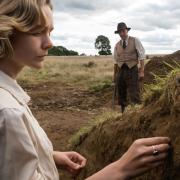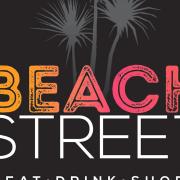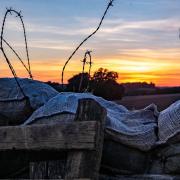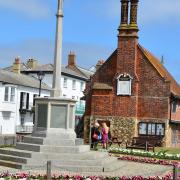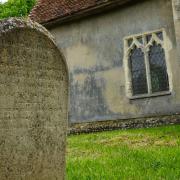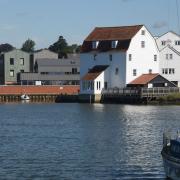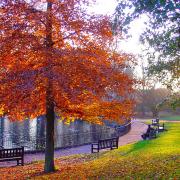Essex man Martin Newell crosses the border to visit East Bergholt
Essex man Martin Newell crosses the border to visit East Bergholt
Over the White Bridge at Manningtree and across the River Stour. East Bergholt is about as close as you can be to my own county of Essex and yet still be ‘abroad’ in neighbouring Suffolk.
How do you know you’ve crossed the border? It’s hard to explain, really, but once over the Stour, the fields seem smaller than the vast flat expanses of the Essex ones. In addition, the land undulates rather more. The lanes seem shadier with trees and the steady climb of the road to East Bergholt serves to remind you that you are now in the Dedham Vale.
There are two main ways of getting to East Bergholt from the south. One is along the big roaring A12, taking a right turn. This can be hateful enough in a car, but it’s especially wretched for a cyclist. The other way is to go the quieter Manningtree route along the A137, turning off up the Hadleigh road. If you’re on foot, you can also walk in the artist, Constable’s footsteps along the footpath to East Bergholt from Dedham.
East Bergholt, which despite it being only about 12 miles from my home, is a place which I will sometimes go for years without visiting. I forget how beautiful it is, how stunningly well-cared for and how vibrant it can seem. There is something in the order of 80 listed buildings here – each one a slice of our rather over-venerated heritage cake. And yet, East Bergholt does not carry that twee picture postcard prettiness which often stifles the life out of other places of similar antiquity. Sure, there is almost certainly wealth around here and I doubt if you’d buy much more than a small bungalow on its outskirts for under about 350k. But the village, when you visit it has the feel of a place which is open for business and crucially, at work. Unlike certain other pretty villages, it’s not deathly quiet, waiting for its commuter owners to come home.
On the weekday morning when I visit, the pharmacy, the general stores, an artisan baker (yes, really) and a workshop are all open for business. East Bergholt also has its own high school, with a catchment area serving several nearby villages. On the village’s main thoroughfare people are chatting, buying newspapers, walking dogs and generally perambulating.
I visited the church of St Mary the Virgin. As is so often the case in Suffolk, East Bergolt is another small place with an unnecessarily magnificent church – a result of a once-thriving, now long-ceased wool trade. Outside the church is its now famous bell-cage, originally a temporary construction which then became permanent. Inside the bell cage are five of the heaviest church bells in England, which frankly, I’m not surprised, were finally parked at ground level, rather than being hoisted into a tower. Inside the church, I was lucky enough to meet the verger, Mr Rodney Brundle, a most helpful and witty man, who as well as showing me a short film of the churchbells in action, filled in a few details for me about East Bergholt itself.
Opposite the church is Old Hall, home to a community of people, established in the mid 197Os. Largely self sufficient, they keep livestock and grow their own food. Although founded on familiar post-1960s alternative principles, the perennially practical Old Hall community has never really been a hippy commune. Thirty-five years ago, however, when they first arrived, the quiet village of East Bergolt, did not quite know what to expect. As Rodney Brundle recalled to me, somewhat tongue-in-cheek: "When we heard there was a commune coming, we thought there was going to be breastfeeding down the street and all sorts of things." The verger paused, before joking: "I looked – but I never saw anything."
On a more serious note, he added that the community, which is generally well thought-of in Bergholt, is now an ageing one. This has presented the members with a problem. The young of the community, upon reaching adulthood will now sometimes find themselves unable to raise the funds to buy into the place. In short, the Old Hall Community has perhaps found itself prey to the same trammels as those which blight the outside world.
Almost opposite East Bergholt’s lovely church is a country lane called Flatford Road. It is worth a wander down this lane, situated just behind the grounds of Old Hall. Suddenly you will see a large swathe of the Dedham Vale laid out before you, with the high tower of Dedham church itself standing up in the middle distance. Now, they may declare a particular location an Area of Outstanding Natural Beauty – an AONB – as the people in charge of such things have done in this case. Nothing, though, will quite prepare you for the actuality of such a view, should you just stumble upon it from an unexpected angle and at an unexpected moment, as I did. In the hazy days of a late summer, with the hedgerow fruits already beginning to ripen and the treetops deep green and waxy, I stand and stare southwards at this chunk of my native country.
If I’d seen the same view, say, in a film, I’d probably accuse the cinematographer of doctoring the shot. It’s real enough though, and just along the road is Fenbridge Lane, which is about a horse wide and will eventually take you to Dedham, along the same route which the painter John Constable, walked to school. You’ll hear a lot about John Constable in East Bergholt and Dedham. The two villages – and by default their respective counties – always seem to tussle over the dead artist like a couple of tetchy sisters over a cherished teddy bear.
Constable, who lived in the one place and went to school in the other, if he were to return here today would probably be puzzled about all the kerfuffle. If the artist doesn’t return here, however, I will. I want to tackle that walk, again.



